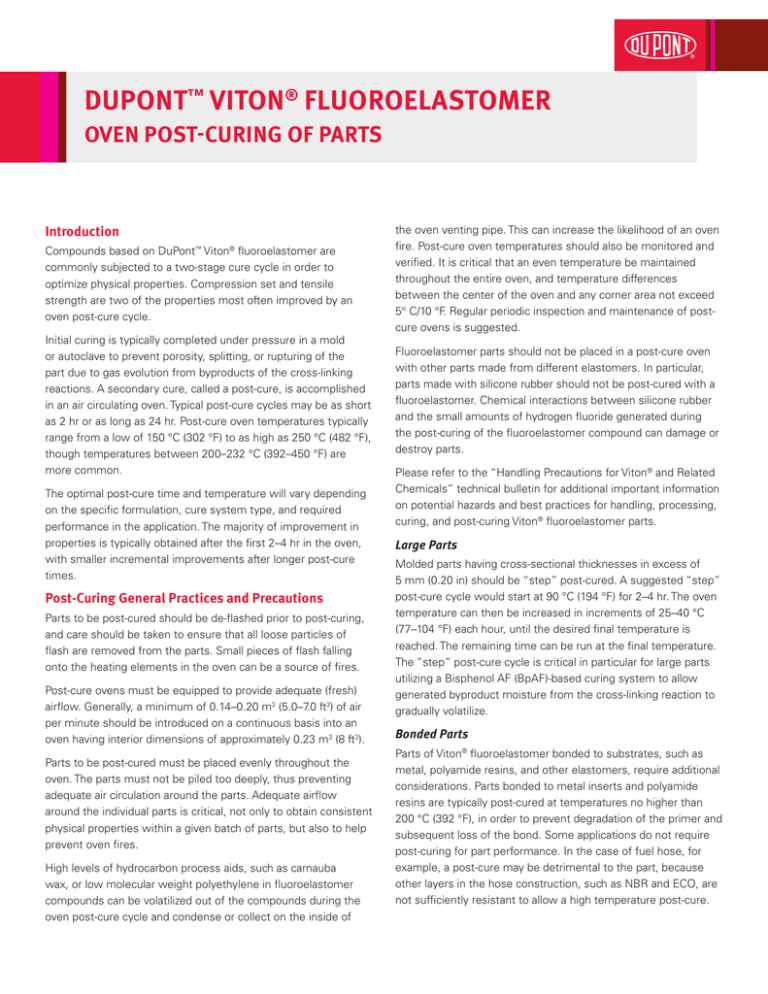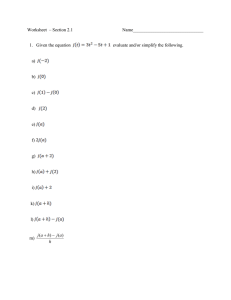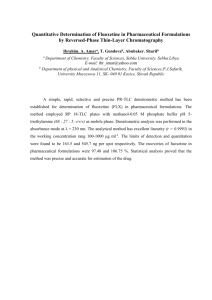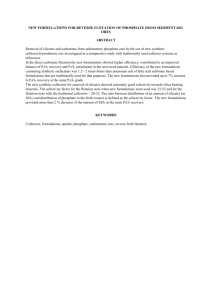
DUPONT™ VITON® FLUOROELASTOMER
OVEN POST-CURING OF PARTS
Introduction
Compounds based on DuPont™ Viton® fluoroelastomer are
commonly subjected to a two-stage cure cycle in order to
optimize physical properties. Compression set and tensile
strength are two of the properties most often improved by an
oven post-cure cycle.
Initial curing is typically completed under pressure in a mold
or autoclave to prevent porosity, splitting, or rupturing of the
part due to gas evolution from byproducts of the cross-linking
reactions. A secondary cure, called a post-cure, is accomplished
in an air circulating oven. Typical post-cure cycles may be as short
as 2 hr or as long as 24 hr. Post-cure oven temperatures typically
range from a low of 150 °C (302 °F) to as high as 250 °C (482 °F),
though temperatures between 200–232 °C (392–450 °F) are
more common.
The optimal post-cure time and temperature will vary depending
on the specific formulation, cure system type, and required
performance in the application. The majority of improvement in
properties is typically obtained after the first 2–4 hr in the oven,
with smaller incremental improvements after longer post-cure
times.
Post-Curing General Practices and Precautions
Parts to be post-cured should be de-flashed prior to post-curing,
and care should be taken to ensure that all loose particles of
flash are removed from the parts. Small pieces of flash falling
onto the heating elements in the oven can be a source of fires.
Post-cure ovens must be equipped to provide adequate (fresh)
airflow. Generally, a minimum of 0.14–0.20 m3 (5.0–7.0 ft3) of air
per minute should be introduced on a continuous basis into an
oven having interior dimensions of approximately 0.23 m3 (8 ft3).
Parts to be post-cured must be placed evenly throughout the
oven. The parts must not be piled too deeply, thus preventing
adequate air circulation around the parts. Adequate airflow
around the individual parts is critical, not only to obtain consistent
physical properties within a given batch of parts, but also to help
prevent oven fires.
High levels of hydrocarbon process aids, such as carnauba
wax, or low molecular weight polyethylene in fluoroelastomer
compounds can be volatilized out of the compounds during the
oven post-cure cycle and condense or collect on the inside of
the oven venting pipe. This can increase the likelihood of an oven
fire. Post-cure oven temperatures should also be monitored and
verified. It is critical that an even temperature be maintained
throughout the entire oven, and temperature differences
between the center of the oven and any corner area not exceed
5° C/10 °F. Regular periodic inspection and maintenance of postcure ovens is suggested.
Fluoroelastomer parts should not be placed in a post-cure oven
with other parts made from different elastomers. In particular,
parts made with silicone rubber should not be post-cured with a
fluoroelastomer. Chemical interactions between silicone rubber
and the small amounts of hydrogen fluoride generated during
the post-curing of the fluoroelastomer compound can damage or
destroy parts.
Please refer to the “Handling Precautions for Viton® and Related
Chemicals” technical bulletin for additional important information
on potential hazards and best practices for handling, processing,
curing, and post-curing Viton® fluoroelastomer parts.
Large Parts
Molded parts having cross-sectional thicknesses in excess of
5 mm (0.20 in) should be “step” post-cured. A suggested “step”
post-cure cycle would start at 90 °C (194 °F) for 2–4 hr. The oven
temperature can then be increased in increments of 25–40 °C
(77–104 °F) each hour, until the desired final temperature is
reached. The remaining time can be run at the final temperature.
The “step” post-cure cycle is critical in particular for large parts
utilizing a Bisphenol AF (BpAF)-based curing system to allow
generated byproduct moisture from the cross-linking reaction to
gradually volatilize.
Bonded Parts
Parts of Viton® fluoroelastomer bonded to substrates, such as
metal, polyamide resins, and other elastomers, require additional
considerations. Parts bonded to metal inserts and polyamide
resins are typically post-cured at temperatures no higher than
200 °C (392 °F), in order to prevent degradation of the primer and
subsequent loss of the bond. Some applications do not require
post-curing for part performance. In the case of fuel hose, for
example, a post-cure may be detrimental to the part, because
other layers in the hose construction, such as NBR and ECO, are
not sufficiently resistant to allow a high temperature post-cure.
Effect of Post-Cure Time and Oven Temperature
on Properties
Formulations
Oven post-cure cycles are known to have significant effects on
properties in formulations utilizing BpAF curing systems, but
effects are also seen in formulations utilizing peroxide curing
systems. Formulations of each were tested to quantify post-cure
effects at oven temperatures of 200 °C and 232 °C (392 °F and
450 °F) for up to 24 hr exposure (Table 1).
Three BpAF-cured formulations based upon Viton® A-401C
fluoroelastomer were evaluated. Formulation 1 contains
a standard metal oxide system without process aids.
Formulation 2 includes a VPA #2 process aid. Formulation 3 uses
a high magnesium oxide system (no calcium hydroxide) with no
process aids.
Three peroxide-cured formulations based upon Viton® GF-600S
fluoroelastomer were also evaluated. Formulation 4 is a standard
peroxide and coagent-cured formulation containing no process
aids and a no-metal oxide (NMO) formulation. Formulation 5
includes a metal oxide, zinc oxide, as a heat stabilizer and is also
without process aids. Formulation 6 is a NMO formulation and
includes a process aid.
It should be noted that all of the test formulations in this study
are reinforced with carbon black. Experience has shown that
mineral-filled Viton® fluoroelastomer formulations typically require
longer post-cure cycles to obtain optimal properties.
2
Compression Set
The majority of improvement in compression set is obtained in
the first 4 hr of post-curing at both 200 °C and 232 °C (392 °F
and 450 °F) (Table 3). BpAF-cured formulations benefit from
longer cure cycles at higher post-cure temperatures. However,
peroxide-cured formulations reach their optimal compression
set after 24 hr at 200 °C (392 °F) and 8 hr at 232 °C (450 °F).
Longer post-cure cycles at 232 °C (450 °F) result in increased
compression set results (Figures 1 and 2). The lowest
compression set is obtained in formulations without process
aids, regardless of cure system or post-cure cycle.
Tensile Strength
The majority of improvement in tensile strength is obtained in
the first 4 hr of post-curing at 200 °C (392 °F) in peroxide-cured
formulations, while BpAF-cured formulations see continual
improvement out to 24 hr (Table 4, Figure 3). Post-curing at
232 °C (450 °F) provides the majority of improvement after
8 hr in both peroxide- and BpAF-cured formulations (Figure 4).
Process aid addition appears detrimental only when post-curing
BpAF-cured formulations at 200 °C (392 °F).
Additional Properties
Elongation, hardness, and modulus are also effected by postcure cycles. The higher strain modulus (stress at 100% strain) is
significantly affected. Large increases of M100 are observed in
the longer post-cure cycles (Table 7), particularly in formulations
containing process aids. The increase in low strain modulus
(stress at 25% strain) due to post-cure conditions is somewhat
less (Table 8). The change in hardness due to post-curing is
relatively small with typically less than four Shore A points
increase.
Figure 1. Compression Set After 200 °C (392 °F) Post-Cure
Bisphenol AF-Cured Formulations
Peroxide-Cured Formulations
50
50
A-401C
A-401C + process aid
A-401C high MgO
40
30
% Set
% Set
40
20
10
0
GF-600S
GF-600S + process aid
GF-600S + ZnO
30
20
10
0
4
8
12
16
20
0
24
0
Post-Cure at 200 °C (392 °F), hr
4
8
12
16
20
24
Post-Cure at 200 °C (392 °F), hr
Figure 2. Compression Set After 232 °C (450 °F) Post-Cure
Bisphenol AF-Cured Formulations
Peroxide-Cured Formulations
50
50
A-401C
A-401C + process aid
A-401C high MgO
40
30
% Set
% Set
40
20
10
0
GF-600S
GF-600S + process aid
GF-600S + ZnO
30
20
10
0
4
8
12
16
20
Post-Cure at 232 °C (450 °F), hr
24
0
0
4
8
12
16
20
24
Post-Cure at 232 °C (450 °F), hr
3
Figure 3. Tensile Strength After 200 °C (392 °F) Post-Cure
Bisphenol AF-Cured Formulations
Peroxide-Cured Formulations
25
30
25
Tensile, MPa
Tensile, MPa
20
15
10
A-401C
A-401C + process aid
A-401C high MgO
5
0
0
4
8
12
16
20
20
15
10
GF-600S
GF-600S + process aid
GF-600S + ZnO
5
0
24
0
Post-Cure at 200 °C (392 °F), hr
4
8
12
16
20
24
Post-Cure at 200 °C (392 °F), hr
Figure 4. Tensile Strength After 232 °C (450 °F) Post-Cure
Bisphenol AF-Cured Formulations
Peroxide-Cured Formulations
25
30
25
15
10
A-401C
A-401C + process aid
A-401C high MgO
5
0
0
4
8
12
16
20
Post-Cure at 232 °C (450 °F), hr
4
Tensile, MPa
Tensile, MPa
20
20
15
10
GF-600S
GF-600S + process aid
GF-600S + ZnO
5
24
0
0
4
8
12
16
20
Post-Cure at 232 °C (450 °F), hr
24
Table 1. Formulations
#1
#2
#3
#4
#5
#6
E113074-056
A-401C
A-401C
+ process aid
A-401C
high MgO
GF-600S
GF-600S
+ process aid
GF-600S
+ ZnO
Viton® A-401C
100
100
100
100
100
100
30
30
30
Viton® GF-600S
N990 Carbon Black
30
30
Calcium Hydroxide
6
6
MgO High Activity
3
3
30
9
Zinc Oxide
3
Diak 7
2.5
2.5
2.5
Varox® DBPH-50
1.5
1.5
1.5
™
VPA 2
0.75
Struktol® HT-290
0.75
Total phr
139.00
139.75
139.00
134.00
134.75
137.00
#1
#2
#3
#4
#5
#6
A-401C
A-401C
+ process aid
A-401C
high MgO
GF-600S
GF-600S
+ process aid
GF-600S
+ ZnO
Table 2. Compound Rheology
MDR
10’, 177 °C (350 °F),
0.5° arc
ML [dNm]
2.0
2.0
2.1
2.2
1.9
2.2
MH [dNm]
33.1
33.7
29.7
33.9
29.7
33.8
ts2 [min]
0.9
0.9
1.1
0.4
0.4
0.4
t’50 [min]
1.2
1.2
2.2
0.8
0.8
0.7
t’90 [min]
1.8
2.0
3.8
1.6
1.4
1.3
t’95 [min]
2.2
2.5
5.0
2.1
1.9
1.7
GF-600S
GF-600S
+ process aid
GF-600S
+ ZnO
Table 3. Compression Set, % — Aged 70 hr at 200 °C (392 °F)
Post-Cure Conditions
Temperature,
°C (°F)
Time,
hr
No post-cure
200 (392)
4
Formulations
A-401C
A-401C
+ process aid
A-401C
high MgO
37
39
31
24
41
26
22
28
20
25
33
23
200 (392)
8
22
26
19
24
30
22
200 (392)
16
20
25
18
23
29
21
200 (392)
24
21
24
17
22
28
20
232 (450)
4
21
25
18
21
32
20
232 (450)
8
20
23
17
21
28
20
232 (450)
16
18
22
15
25
28
23
232 (450)
24
16
22
14
29
30
24
5
Table 4. Tensile Strength, MPa
Post-Cure Conditions
Temperature,
°C (°F)
Time,
hr
No post-cure
Formulations
A-401C
A-401C
+ process aid
A-401C
high MgO
GF-600S
GF-600S
+ process aid
GF-600S
+ ZnO
10.3
9.3
12.3
16.2
13.3
15.3
200 (392)
4
14.8
11.6
14.5
21.1
20.4
21.5
200 (392)
8
13.9
11.6
15.2
19.4
18.6
21.6
200 (392)
16
15.2
13.1
17.1
20.8
20.6
20.9
200 (392)
24
14.9
13.7
16.3
20.2
22.8
21.2
232 (450)
4
15.6
13.0
17.4
21.4
23.9
22.3
232 (450)
8
15.9
16.4
17.6
24.2
24.9
22.2
232 (450)
16
16.1
16.5
16.5
23.2
21.9
21.8
232 (450)
24
17.4
17.1
19.5
24.3
24.9
22.0
A-401C
A-401C
+ process aid
A-401C
high MgO
GF-600S
+ process aid
GF-600S
+ ZnO
Table 5. Elongation, %
Post-Cure Conditions
Temperature,
°C (°F)
Time,
hr
No post-cure
Formulations
GF-600S
252
257
314
285
380
272
200 (392)
4
237
248
250
283
369
301
200 (392)
8
207
233
264
243
303
315
200 (392)
16
231
234
274
247
287
286
200 (392)
24
232
230
259
239
308
278
232 (450)
4
224
199
249
241
323
294
232 (450)
8
208
207
244
276
290
290
232 (450)
16
202
190
221
269
250
270
232 (450)
24
200
186
236
310
304
282
Table 6. Hardness, Shore A pts
Post-Cure Conditions
Temperature,
°C (°F)
Time,
hr
A-401C
A-401C
+ process aid
A-401C
high MgO
GF-600S
GF-600S
+ process aid
GF-600S
+ ZnO
74
74
71
71
70
72
4
75
75
73
74
75
75
200 (392)
8
76
76
73
74
75
75
200 (392)
16
76
77
71
75
77
75
200 (392)
24
75
76
73
75
77
75
232 (450)
4
77
76
72
74
77
75
232 (450)
8
77
77
72
74
78
75
No post-cure
200 (392)
6
Formulations
232 (450)
16
76
79
74
75
77
76
232 (450)
24
77
78
73
73
75
76
Table 7. Stress at 100% Strain, MPa
Post-Cure Conditions
Temperature,
°C (°F)
Time,
hr
No post-cure
Formulations
A-401C
A-401C
+ process aid
A-401C
high MgO
GF-600S
GF-600S
+ process aid
GF-600S
+ ZnO
4.86
4.68
4.33
4.68
3.48
4.52
200 (392)
4
6.13
5.20
4.81
5.88
4.70
5.56
200 (392)
8
6.01
5.41
4.82
6.20
5.11
5.58
200 (392)
16
6.39
5.78
5.32
6.27
5.78
5.91
200 (392)
24
6.32
5.96
5.18
6.17
6.36
5.89
232 (450)
4
6.34
6.07
5.16
6.28
5.55
5.59
232 (450)
8
6.77
7.14
5.57
6.66
6.31
5.99
232 (450)
16
7.03
7.66
5.83
6.54
7.08
6.29
232 (450)
24
7.50
7.97
5.65
6.35
6.56
5.97
A-401C
+ process aid
A-401C
high MgO
GF-600S
+ process aid
GF-600S
+ ZnO
Table 8. Stress at 25% Strain, MPa
Post-Cure Conditions
Temperature,
°C (°F)
Time,
hr
No post-cure
Formulations
A-401C
GF-600S
1.87
1.78
1.65
1.34
1.29
1.28
200 (392)
4
1.86
1.84
1.67
1.49
1.64
1.58
200 (392)
8
1.93
1.94
1.64
1.61
1.75
1.61
200 (392)
16
1.99
1.93
1.69
1.57
1.82
1.59
200 (392)
24
2.07
1.94
1.71
1.58
1.92
1.62
232 (450)
4
1.95
1.90
1.67
1.52
1.72
1.59
232 (450)
8
2.10
1.98
1.71
1.58
1.84
1.59
232 (450)
16
2.04
2.22
1.83
1.65
1.93
1.58
232 (450)
24
2.08
2.13
1.68
1.63
1.93
1.62
7
Test Procedure
Compression Set
ASTM D395, Method B (25% deflection)
Hardness
ASTM D1414, Durometer A
MDR
ASTM D5289
Stress/Strain Properties
ASTM D412, pulled at 8.5 mm/s (20 in/min)
Visit us at viton.dupont.com
Contact DuPont at the following regional locations:
North America
800-222-8377
Latin America
+0800 17 17 15
Europe, Middle East, Africa
+41 22 717 51 11
Greater China
ASEAN
Japan
+86-400-8851-888+65-6586-3688 +81-3-5521-8484
The information provided in this data sheet corresponds to our knowledge on the subject at the date of its publication. This information may be subject to revision as new knowledge and experience becomes
available. The data provided fall within the normal range of product properties and relate only to the specific material designated; these data may not be valid for such material used in combination with any other
materials, additives or pigments or in any process, unless expressly indicated otherwise.
The data provided should not be used to establish specification limits or used alone as the basis of design; they are not intended to substitute for any testing you may need to conduct to determine for yourself
the suitability of a specific material for your particular purposes. Because DuPont cannot anticipate all variations in actual end use and disposal conditions, DuPont does not guarantee favorable results, makes
no warranties and assumes no liability in connection with any use of this information. All such information is given and accepted at the buyer’s risk. It is intended for use by persons having technical skill, at their
own discretion and risk. Nothing in this publication is to be considered as a license to operate under or a recommendation to infringe any patent. DuPont advises you to seek independent counsel for a freedom to
practice opinion on the intended application or end use of our products.
CAUTION: Do not use DuPont materials in medical applications involving implantation in the human body or contact with internal body fluids or tissues, unless the material has been provided from DuPont under a
written contract that is consistent with DuPont policy regarding medical applications and expressly acknowledges the contemplated use. For further information, please contact your DuPont representative. You may
also request a copy of DuPont POLICY Regarding Medical Applications H-50103-4 and DuPont CAUTION Regarding Medical Applications H-50102-4.
Struktol® is a trademark of Schill & Seilacher Corp.
Varox® and Diak® are trademarks of R.T. Vanderbilt Co.
Copyright © 2014 DuPont. All rights reserved. The DuPont Oval Logo, DuPont™, and Viton® are registered trademarks or trademarks of E.I. du Pont de Nemours and Company or its affiliates.
K-28395 (11/14)






